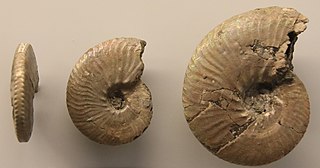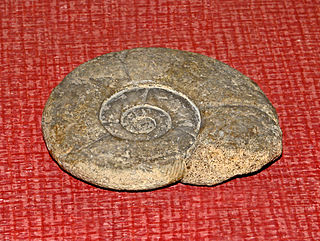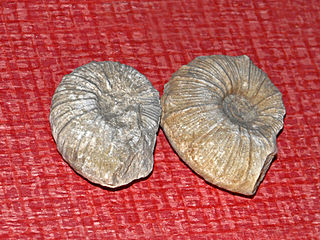
Australiceras is an extinct ammonite genus from the upper part of the Early Cretaceous, Aptian stage, included in the family Ancyloceratidae.

Anahoplites is a genus of rather involute, compressed hoplitid ammonites with flat sides, narrow flat or grooved venters, and flexious ribs or striae arising from weak umbilicle tubercles that end in fine dense ventrolateral nodes. The elements of their sutures are short, wide and jaggedy. Specimens of Annahoplites have diameters typically in the range of 4–6 centimetres (1.6–2.4 in) although some with diameters of as much as 19 centimetres (7.5 in) have been reported. The genus lived during the Cretaceous, from the Middle to the late Albian.
Beudanticeras is an extinct cephalopod genus from the Late Cretaceous period; Albian and Cenomanian, belonging to the ammonoid subclass and included in the family Desmoceratidae.
Anisoceratidae is an extinct family of heteromorph ammonites which belong to the Ancyloceratina superfamily Turrilitoidea. Members of the family range is from the lower Albian to the upper Turonian. The family is possibly derived from a member of the Hamitidae.
Ermoceras is a genus of ammonite belonging to the Thomboceratidae family of the Middle Jurassic found in deposites of central Arabia, Sinai, and Algeria with strong primary and secondary ribs and a single row of lateral tubercles; described as having a deep ventral groove

Placenticeras is a genus of ammonites from the Late Cretaceous. Its fossils have been found in Asia, Europe, North and South America.

Mammites is a Late Cretaceous ammonite genus included in the acanthoceratoidean family, Acanthoceratidae, and the type genus for the subfamily Mammitinae. Mammites was named by Laube and Bruder in 1887.

Engonoceratidae is a family of typically compressed, more or less flat sided and involute ammonites from the mid Cretaceous belonging to the Hoplitoidea. shells have flat sided outer rims ( venters), at least in some stage. Single or branching irregular ribs and variably placed tubercles may occur. Sutures have numerous auxiliary and adventive elements of similar form, in general radially arranged. Forwardly divergent saddles tend to be simple, without subdivision. Lobes, pointing apically, may be simple and undivided or may be frilled with short irregular serrations.
Shloenbachiidae is a family of hoplitoid ammonoid cephalopds mostly from the lower Upper Cretaceous,.
Dipoloceras is a rather evolute, strongly ribbed and well keeled acanthocerataean ammonite from the Albian stage of the Lower Cretaceous included in the brancoceratid subfamily Mojsisovicziinae. The whorl section is typically inflated or depressed. Ribs are high standing, may be sharp, close to wide spaced. The ventral keel may sit below the level of the ribs.
Brancoceratidae is a family of acanthoceratoid ammonites from the middle of the Cretaceous, recognized by their commonly evolute shells with round, oval, or quadrate whorls, strong ribs, usual ventral keels, and at least, umblical tubercles. The family is thought to be derived from the Desmoceratidae (Desmoceratoidea), perhaps from Silesitoides or some allied genus.

Hypophylloceras is a Cretaceous ammonite with a finely ribbed, compressed, involute shell; some having periodic stronger ribs or folds. The suture is complex, with large, asymmetric and finely divided lobes; the 1st lateral being much larger than the external (=ventral) and 2nd lateral lobes. Saddle endings commonly not phylloid.

Lytoceratinae is a subfamily of ammonoid cephalopods that make up part of the family Lytoceratidae.

Neocomites is a genus of ammonite from the Lower Cretaceous, Berriasian to Hauterivian, and type genus for the Neocomitidae.

Puzosia is a genus of desmoceratid ammonites, and the type genus for the Puzosiinae, which lived during the middle part of the Cretaceous, from early Aptian to Maastrichtian. Sepkoski defines the range from Albian to Santonian. The generic name comes from the Serbian words "Puž" (snail) and "oce/ose" (axis), gaining its name from the shell's snail-like appearance.

Holcodiscidae is an ammonite family placed in the superfamily Desmoceratoidea.

Holcodiscus is an extinct ammonite genus placed in the family Holcodiscidae. Species in this genus were fast-moving nektonic carnivores. The type species of the genus is Ammonites caillaudianus.
Tragodesmoceras is a large moderately involute ammonite with deeply embracing whorls that are higher than wide, a steep sided umbilicus and a narrowly rounded venter. Ornament consists of primary ribs that begin at the umbilical shoulder and smaller secondary ribs that begin mid flank. Ribs are sigmodal, periodically thickened and bent forward on the outer flank to cross the venter as chevrons. The suture has a broad trifid lateral lobe.
Cunningtoniceras is a stocky acanthoceratid ammonite from the upper Cenomanian stage of the late Cretaceous of the western U.S., found e.g. in Arizona and New Mexico.
Flickiidae is a family of dwarf ammonites with little ornament and very simples sutures known from small pyritic specimens found in middle Cretaceous deposits. Inclusion in the Acanthoceratoidea is tentative.











